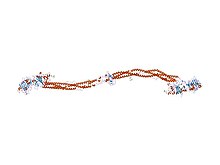
Back فبرينوجين Arabic Fibrinogen Azerbaijani Fibrinogen BS Fibrinogen Catalan Fibrinogen Czech Fibrinogen German Ινωδογόνο Greek Fibrinógeno Spanish Fibrinogeno Basque فیبرینوژن Persian
| Fibrinogen alpha/beta chain family | |||||||||
|---|---|---|---|---|---|---|---|---|---|
 crystal structure of native chicken fibrinogen with two different bound ligands | |||||||||
| Identifiers | |||||||||
| Symbol | Fib_alpha | ||||||||
| Pfam | PF08702 | ||||||||
| InterPro | IPR012290 | ||||||||
| SCOP2 | 1m1j / SCOPe / SUPFAM | ||||||||
| |||||||||
| Fibrinogen alpha C domain | |||||||||
|---|---|---|---|---|---|---|---|---|---|
| Identifiers | |||||||||
| Symbol | Fibrinogen_aC | ||||||||
| Pfam | PF12160 | ||||||||
| InterPro | IPR021996 | ||||||||
| |||||||||
| Identifiers | |||||||||
|---|---|---|---|---|---|---|---|---|---|
| Symbol | Fibrinogen_C | ||||||||
| Pfam | PF00147 | ||||||||
| Pfam clan | CL0422 | ||||||||
| InterPro | IPR002181 | ||||||||
| PROSITE | PDOC00445 | ||||||||
| SCOP2 | 1fza / SCOPe / SUPFAM | ||||||||
| |||||||||
Fibrinogen (coagulation factor I) is a glycoprotein complex, produced in the liver,[1] that circulates in the blood of all vertebrates.[2] During tissue and vascular injury, it is converted enzymatically by thrombin to fibrin and then to a fibrin-based blood clot. Fibrin clots function primarily to occlude blood vessels to stop bleeding. Fibrin also binds and reduces the activity of thrombin. This activity, sometimes referred to as antithrombin I, limits clotting.[1] Fibrin also mediates blood platelet and endothelial cell spreading, tissue fibroblast proliferation, capillary tube formation, and angiogenesis and thereby promotes revascularization and wound healing.[3]
Reduced and/or dysfunctional fibrinogens occur in various congenital and acquired human fibrinogen-related disorders. These disorders represent a group of rare conditions in which individuals may present with severe episodes of pathological bleeding and thrombosis; these conditions are treated by supplementing blood fibrinogen levels and inhibiting blood clotting, respectively.[4][5] These disorders may also be the cause of certain liver and kidney diseases.[1]
Fibrinogen is a "positive" acute-phase protein, i.e. its blood levels rise in response to systemic inflammation, tissue injury, and certain other events. It is also elevated in various cancers. Elevated levels of fibrinogen in inflammation as well as cancer and other conditions have been suggested to be the cause of thrombosis and vascular injury that accompanies these conditions.[6][7]
- ^ a b c de Moerloose P, Casini A, Neerman-Arbez M (September 2013). "Congenital fibrinogen disorders: an update". Seminars in Thrombosis and Hemostasis. 39 (6): 585–595. doi:10.1055/s-0033-1349222. PMID 23852822.
- ^ Jiang Y, Doolittle RF (June 2003). "The evolution of vertebrate blood coagulation as viewed from a comparison of puffer fish and sea squirt genomes". Proceedings of the National Academy of Sciences of the United States of America. 100 (13): 7527–7532. Bibcode:2003PNAS..100.7527J. doi:10.1073/pnas.0932632100. PMC 164620. PMID 12808152.
- ^ Mosesson MW (August 2005). "Fibrinogen and fibrin structure and functions". Journal of Thrombosis and Haemostasis. 3 (8): 1894–1904. doi:10.1111/j.1538-7836.2005.01365.x. PMID 16102057. S2CID 22077267.
- ^ Casini A, de Moerloose P, Neerman-Arbez M (June 2016). "Clinical Features and Management of Congenital Fibrinogen Deficiencies". Seminars in Thrombosis and Hemostasis. 42 (4): 366–374. doi:10.1055/s-0036-1571339. PMID 27019462. S2CID 12038872.
- ^ Undas A (September 2011). "Acquired dysfibrinogenemia in atherosclerotic vascular disease". Polskie Archiwum Medycyny Wewnetrznej. 121 (9): 310–319. PMID 21952526.
- ^ Davalos D, Akassoglou K (January 2012). "Fibrinogen as a key regulator of inflammation in disease". Seminars in Immunopathology. 34 (1): 43–62. doi:10.1007/s00281-011-0290-8. PMID 22037947. S2CID 14997530.
- ^ Repetto O, De Re V (September 2017). "Coagulation and fibrinolysis in gastric cancer". Annals of the New York Academy of Sciences. 1404 (1): 27–48. Bibcode:2017NYASA1404...27R. doi:10.1111/nyas.13454. PMID 28833193. S2CID 10878584.